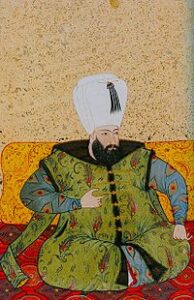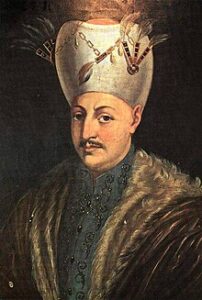He was the 93rd Islamic caliph and the 14th Sultan of the Ottoman Empire. For the first time in Ottoman history, Ahmet I, the son of Mehmet and Handan Sultan, became the Sultan of the Ottoman Empire without first passing through the Sanjak.
RIGHT IN FRONT OF THE STONE
Ahmet I, his father III. The year he was born was during Mehmet’s reign as Sancakbeyi of Manisa. He relocated to Istanbul with his father once his father was elevated to the position of Sultan.
The second wife of Ahmet I was the mother of Ahmet I. In his first marriage, Sultan Mehmet was married to Halime Sultan, and the couple had three children together. As a result of the premature deaths of two of the three children born to the first wife, Halime Sultan’s final son was elevated to the position of crown prince. The crown prince was put to death by strangulation after it became known throughout the palace that the newly appointed crown prince could be plotting to ascend to the throne. Thus, when there was no hope, Ahmet I became the compulsory heir to the throne, even though he was the child of the second marriage.
THE PERIOD OF REIGN
III. After Murat suffered a heart attack and died, he became sultan on December 21, 1603, with the enthronement ceremony performed the very following day.
Since he arrived to the throne at a relatively early age, the first two years of his reign were spent in school.
When the Ottoman Empire fell into a tough condition due to the continual battles, a peace policy was sought to be implemented.
TREATY OF ZITVATOROK
The continuous battles between the Ottoman Empire and Austria had seriously devastated both empires socio-economically. In prior peace deals, the agreements were postponed when the criteria demanded by the parties could not be reached.
 However, with the Treaty of Zitvatorok signed between Esztergom and Komorom on 11 November 1606, where the Zitva river flows into the Danube River, the parties found peace.
However, with the Treaty of Zitvatorok signed between Esztergom and Komorom on 11 November 1606, where the Zitva river flows into the Danube River, the parties found peace.
According to the Treaty of Zigvatorok:
- Eğri, Estergon, Kanije Castles will stay in the Ottoman Empire, Raab (Yanıkkale) and Komarom Castles will remain in Austria,
- Austria will pay a one-time war compensation of 200,000 gold coins.
- The Archduke of Austria will be regarded equal to the Ottoman Sultan in the etiquette, and the Ottoman Sultan will address the Archduke of Austria with the title of Holy Roman Emperor (Caesar/Kaiser) in correspondence,
- Mutual gifts will be delivered every three years,
- And the yearly 30,000 gold tax that Austria was paying for Hungary will be repealed.
As a result of this arrangement, although the Ottoman Empire looked to be the lucrative side, it was realized that it no longer possessed its prior might. (see articles 3 and 5)
Some people regard this pact to be the most advantageous arrangement struck by the Ottoman Empire.
SAFAVI EVENTS
In the early years when Ahmed I ascended to the throne, the Ottoman Empire was warring against Austria in the west and the Safavids in the east.
In order to recapture back Tabriz, which was lost some time previously, Ottoman soldiers under the direction of Sinan Pasha marched against Shah Abbas and defeated Shah Abbas as a consequence of the conflict. However, when Sefer Pasha, who grasped the chance to win the battle, pursued the enemy troops and abandoned the main army, Shah Abbas, who took the opportunity to divide the army, made a quick attack and destroyed Sinan Pasha.
Thereupon, Shah Abbas made a peace offer and with the Nasuh Pasha Treaty signed in 1612, the Ottoman-Safavid War, which had been going on for 9 years, ended.
NEW INHERITANCE SYSTEM – EKBER AND ERŞET
Ahmet I removed the fratricide law. The mechanism he devised to replace fratricide introduced the legislation that “The eldest man of the family replaces the outgoing Sultan.” According to historians, this new rule led in competition amongst princes and struggles for the throne; It has a very essential relevance in Ottoman history in terms of avoiding the fratricide carried out for the crown.
THE PEAK PERIOD OF THE OTTOMAN
The reign of Ahmet Khan was an era when the state was at its height in terms of geographical extent. The monarchs of the earth knelt before the majesty of this empire and were crowned by the hands of the grand viziers.
From time to time, Sultan Ahmet would undergo asceticism in his little and narrow ascetic on the left side of the mosque he had erected, get away from bustling state concerns and direct his soul to the spiritual climate. He would dwell in a condition of muraqabah and be alone with his Lord.
During the construction of the mosque, Sultan Ahmet had the blessed footprints of the Prophet, termed “Naqsh-i Kadem”, located in the Sultan Qaitbay tomb in Egypt, transferred to the Ayyub Sultan tomb. When the building of the mosque was done, he had it installed in the mosque.
However, the Sultan had the following dream on the night of this transfer:
“A supreme assembly was established in which all the Sultans gathered, and the Prophet (peace be upon him) was sitting in the position of judge. A form of court was established. Sultan Kayitbay filed a lawsuit against Sultan Ahmet for the stealing of this “Kadem-i Seâdet”, which permitted him to visit his grave, and bringing it to Istanbul.
SULTAN AHMET MOSQUE
His mother, Handan Sultan, reared Sultan Ahmet as an extremely devout person. As a consequence of his piety, Sultan Ahmet intended to

have the Selatin Mosque erected in Istanbul. Sedefkâr Mehmed Ağa , one of the most significant architects of the era , was appointed for this Selâtin Mosque.
On January 4, 1610, the foundations of this majestic Selatin Mosque were set, and Sultan Ahmet I himself carried dirt at the hem of his robe during the construction of the mosque.
As a consequence of long and strenuous effort, the Sultanahmet Mosque, whose construction was finished on June 9, 1617, was opened for prayer.
In addition, Şehzadebaşı Kuyucu Murat Pasha Complex, Istanbul İsa Pasha Mosque, Elmalı Ömer Pasha Mosque are among the notable architectural achievements created during his tenure.
Sultan’s death…
 Sultan Ahmet was afflicted with typhus while he was in his mid-20s. Sultan Ahmet, a sultan who gained the enormous affection of the people, passed away at the age of 27 during the night between 21 November and 22 November, when the Selatin Mosque was inaugurated in 1617, and walked to his Mevla. He is interred in his mausoleum near to the Sultanahmet Mosque.
Sultan Ahmet was afflicted with typhus while he was in his mid-20s. Sultan Ahmet, a sultan who gained the enormous affection of the people, passed away at the age of 27 during the night between 21 November and 22 November, when the Selatin Mosque was inaugurated in 1617, and walked to his Mevla. He is interred in his mausoleum near to the Sultanahmet Mosque.
WHERE IS THE TOMB OF SULTAN AHMET I?
He sent one of his students, Şaban Dede. After the funeral prayer performed by Shaykh al-Islam Hocazâde Mehmet Çelebi, he was interred in the mausoleum close to the Sultanahmet Mosque, which he had constructed .
